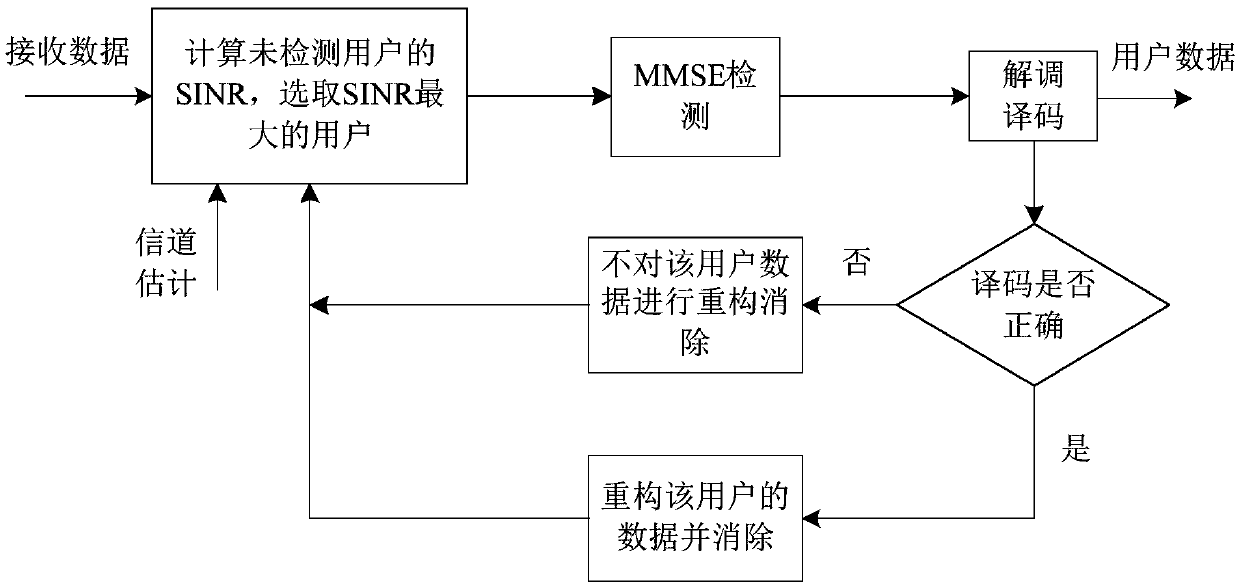Multi-user shared access technology uplink serial first and then parallel multi-user detection method
A multi-user detection and shared access technology, applied in the field of uplink multi-user detection, can solve the problems of poor detection performance, poor detection performance of detection algorithms, and large processing delay, so as to improve detection performance and reduce multiple access. the effect of interference
- Summary
- Abstract
- Description
- Claims
- Application Information
AI Technical Summary
Problems solved by technology
Method used
Image
Examples
specific Embodiment approach 1
[0067] Specific implementation mode 1: The specific process of the multi-user detection method of the multi-user shared access technology uplink in this embodiment is as follows:
[0068] "Serial before parallel" multi-user detection algorithm
[0069] Each iteration of the MMSE-PIC detection algorithm needs to perform MMSE detection on all users, as well as reconstruct and eliminate the MAI generated by all other users except itself. Performance is poor. If the user signal with strong signal can be detected and eliminated as interference before PIC, this is equivalent to removing the largest multiple access interference, and then using PIC to detect the data of other users can get better Detection performance. The essential idea is to perform SIC detection on the users with stronger signals first, and then perform PIC detection on the remaining users with weaker signals, which is equivalent to "serial first, then parallel" multi-user detection.
[0070] The detection algor...
specific Embodiment approach 2
[0093] Embodiment 2: The difference between this embodiment and Embodiment 1 is that the signal R in the step 1 is expressed as:
[0094]
[0095] K represents the number of users, Indicates the expanded data of the kth user, H k Represents the channel coefficient of the kth user, ideal channel estimation is adopted in the present invention; N is the mean value is 0, and the variance is σ 2 Gaussian white noise; S k Indicates the modulated data transmitted by the kth user, W k Indicates the spreading sequence randomly selected by the kth user, and the symbol represents the multiplication of the corresponding position elements of the two matrices; the symbol means W k Each element of the nth column of H k Multiply the nth element of , where n is a positive integer; F k is the equivalent channel coefficient of the kth user;
[0096] According to (1), the equivalent channel coefficient of the kth user is obtained
[0097] Other steps and parameters are the same as ...
specific Embodiment approach 3
[0098] Specific embodiment three: the difference between this embodiment and specific embodiment one or two is: the process of performing MMSE detection on the signal R in the step three one is:
[0099] solve matrix the matrix Multiplied by R, we get
[0100] is the detection coefficient used for MMSE detection of the received signal.
[0101] Other steps and parameters are the same as those in Embodiment 1 or Embodiment 2.
PUM
 Login to View More
Login to View More Abstract
Description
Claims
Application Information
 Login to View More
Login to View More - R&D
- Intellectual Property
- Life Sciences
- Materials
- Tech Scout
- Unparalleled Data Quality
- Higher Quality Content
- 60% Fewer Hallucinations
Browse by: Latest US Patents, China's latest patents, Technical Efficacy Thesaurus, Application Domain, Technology Topic, Popular Technical Reports.
© 2025 PatSnap. All rights reserved.Legal|Privacy policy|Modern Slavery Act Transparency Statement|Sitemap|About US| Contact US: help@patsnap.com



